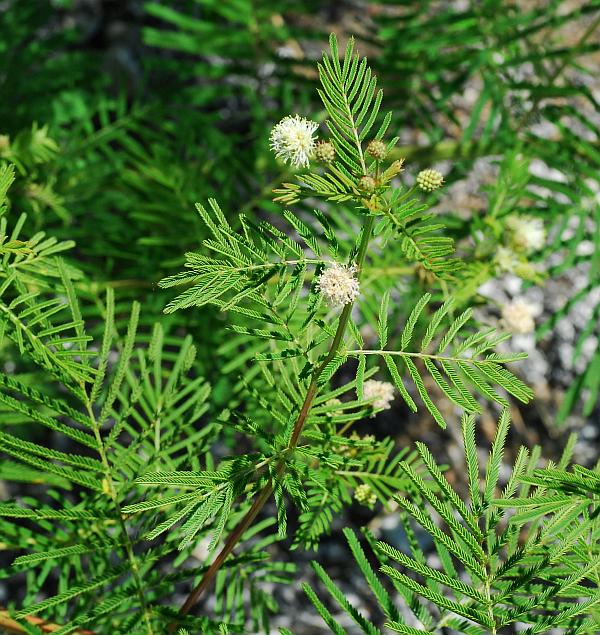Desmanthus illinoensis (Michx.) MacMill. ex B.L. Rob. & Fernald
Illinois Bundle Flower

Native
CC = 3
CW = 3
MOC = 68
© SRTurner
Desmanthus illinoensis (Michx.) MacMill. ex B.L. Rob. & FernaldIllinois Bundle Flower | |
 |
Native CC = 3 CW = 3 MOC = 68 |
© SRTurner |
|
Family - Fabaceae/Mimosoideae Habit - Perennial forb with a thickened, woody taproot. Stems - Ascending to erect, to 1.2 m, multiple from base, much branched, often ridged, glabrous or with a few sparse hairs on ridges above, green when young, becoming reddish brown with age (mostly near the base).
Leaves - Alternate, bipinnately compound, short-petiolate, stipulate. Petioles 0.2-0.5 cm long, the petiole and rachis glabrous or hairy, with a lozenge-shaped gland between the lowermost pair of leaflets, occasionally also between a few of the other leaflet pairs. Stipules inconspicuous, linear to hairlike, 4-9 mm long, with a small, winglike, expanded base. Blades mostly 5.0-8.0 cm long, with 6-12 pairs of pinnae, each pinna with 15-30 pairs of leaflets, usually an even number. Leaflets small, 1.5-4.0 mm long, 0.5-0.8 mm wide, narrowly oblong to linear, oblique at the base, angled or short-tapered to a sharply pointed tip, glabrous or with sparse ascending hairs along the margins.
Inflorescences - Axillary globose pedunculate cluster of 20-70 sessile flowers, 1.0-1.2 cm in diameter. Peduncle 1-4 cm, in flower, elongating in fruit to 3-6 cm, antrorse strigose.
Flowers - Mostly perfect, with a few staminate and/or sterile flowers often produced, these usually smaller than the perfect ones. Calyces 1.4-2.0 mm long (as short as 0.6 mm in sterile flowers), 5-lobed, glabrous, the tube white. Corollas of 5 petals, 2.0-3.3 mm long. Stamens 5, white, glabrous, exserted, the filaments 4-6 mm long. Anthers yellow, 0.2-0.3mm in diameter. Ovary 1 mm long, greenish-white, glabrous. Style 4 mm long, white, glabrous, well exserted.
Fruits - Borne in contorted globose clusters. Individual legumes 1-2 cm long, 5-7 mm wide, asymmetrically oblong, slightly curved to strongly twisted, obliquely rounded at the base, strongly flattened, tapered to a sharply pointed tip, the margins not or only occasionally indented between the seeds, the surfaces not constricted between the seeds, reddish brown to black at maturity, dehiscent along both sutures but more slowly on one side than the other, with 2-5 seeds. Seeds 3-4 mm long, 2.0-2.5 mm wide, obovate to somewhat rhombic in outline.
Flowering - June - August. Habitat - Glades, upland prairies, upland forests, savannas, streambanks, pond margins, fencerows, pastures, fields, railroads, roadsides, open disturbed areas. Origin - Native to the U.S. Lookalikes - Acacia angustissima Other info. - This species can be found throughout most of Missouri, less commonly in the northeast corner of the state and the central Ozark region. Beyond Missouri the plant's main range is within the central and central-south continental U.S. The plant can be identified by its small, globose clusters of white flowers and its bipinnate leaves. Residents of the extreme southwestern portion of Missouri might mistake this plant for Acacia angustissima, except that the latter has many more stamens per flower, giving the flowers clusters a much more dense appearance. A. angustissima also has very dark reddish-brown, woody stems and no glands on the leaf petioles. Photographs taken off Interstate 24 near Nashville, TN., 8-3-05 (DETenaglia); also at Shaw Nature Reserve, Franklin County, MO, 7-24-2007; near Gray Summit, Franklin County, MO, 6-25-2017; Katy Trail near Treloar, Warren County, MO, 7-24-2019; Marais Temps Clair Conservation Area, St. Charles County, MO, 7-5-2020, and St. Joe State Park, St. Francois County, MO, 7-11-2025 (SRTurner). |